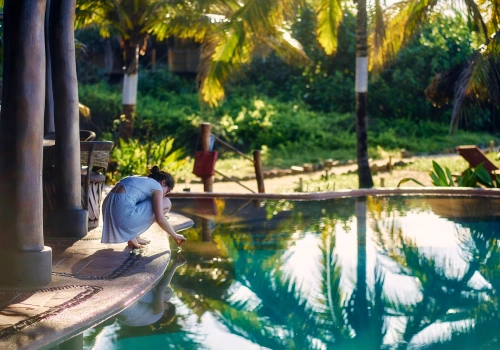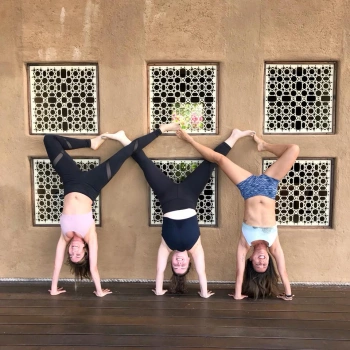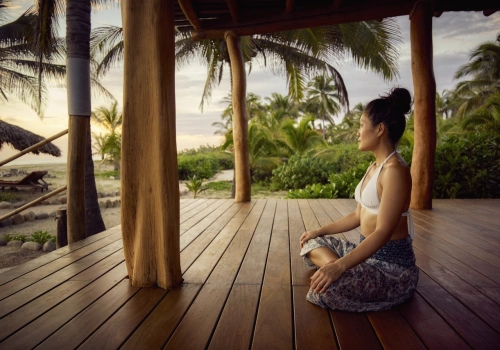Perhaps the only desired side effect of dealing with chronic health issues is that it has made me a master of self-care. I was diagnosed with Lupus SLE with a rheumatoid arthritis crossover at age of 19. At first, the effects were devastating, but in order to keep moving forward despite symptoms, I became increasingly skilled at discovering and implementing healthy habits to regulate the side effects of my disease.
Luckily, practicing yoga asanas to regulate my condition was one of the first tools I discovered. Ultimately, yoga led me beyond the poses, to the full Eight-Limbed Path of Yoga as taught in The Yoga Sutras of Patanjali.

What I discovered practicing the Eight Limbs was an even deeper level of self-care than I thought possible. This is because the limbs of yoga can guide us beyond care of the physical body, to an understanding of our Divine nature, known as Self-Realization, or Samadhi.
Following the Eight Limbs, ultimately leads us to deeper levels of self-care, as they redesign the very definition of Self and Self-knowledge.
1. The first set of practices within the Eight Limbs are suggestions for how we treat others (yamas). There is no doubt that service to others is an excellent method for clearing a cluttered mind, but it is often hard to take care of ourselves if we are weighed down with perceived responsibility toward others. At times we find ourselves so concerned about taking care of family, friends, or work responsibilities, that self-care is neglected entirely. To take care of others in a proportional way, the yamas suggest we treat others in a peaceful, truthful, controlled, self-less, yet energetically-balanced way. If we give too much of our energy, we get burnt out. If we lie, lash out, or are inauthentic in our dealings with those around us, miscommunications and complications will arise. An easy way to ask yourself if you are cultivating balance in your care-taking of others is to pause and ask yourself, “Did this person actually ask for my help/advice?” If the answer is ‘no,’ then you can move back to your side of the street, and bring the reflection back to your own self-care.

2. The second limb of yoga is where we can implement many of the practices we typically think of as self-care. This limb is described as duties or observances towards ourselves (niyamas). The niyamas encourage practices of cleanliness, contentment, self-discipline, self-study, and ritual to cultivate personal equanimity. Go ahead and take that extra-long bath, sip some tea, take time alone to read a life-affirming book, get away for a yoga retreat, or whatever your favorite personal rituals are. Ideally, if you take care of yourself, you are more likely to return to life’s duties present and re-charged.
3. The physical postures (asana) is the limb of yoga that most yogis are taking full advantage of when it comes to self-care. Most yogis have had powerful personal experiences practicing physical yoga. Many rely on the endorphins asana stirs up as an essential part of their self-care routine. Mindful physical exercise of any kind has countless benefits. Connecting to the body, breath and mind, with attention and care, provides positive physical feedback. If the body isn’t healthy and vital than none of our responsibilities will feel affirming or satisfying. I know from my own health journey that addressing the physical body with healthy, well-aligned yoga asanas has made all the difference in taking care of myself.

4. Learning to regulate our energy (prana) -- often through breathing techniques (pranayama) -- is the fourth limb. One of the simplest ways to reconnect with ourselves is to pause and take a breath. Pausing to breathe can slow nervous energy and center the mind. On my yoga retreats I always make sure to teach pranayama and discuss how differing techniques can work for various situations that arise in our lives. When we learn to regulate our energy, especially through the breath, we become skilled at self-affirming action.
5. Taking time away on a yoga retreat is the ultimate opportunity to practice the fifth limb of yoga: sense withdrawal (pratyahara). Distractions are everywhere in modern life. We are exposed to overwhelming amounts of stimuli in our technologically-advanced world. While obviously this technology can be a blessing (we are connecting with each other right now, via this blog), the brain and body can become overwhelmed. The systems of the body, especially the sympathetic nervous system, can’t always perceive if this constant stimuli is stressful or not. The body can be placed in an accidental fight-or-flight response, depleting our systems and zapping our prana. Practicing sense withdrawal can be as easy as turning off your phone, or as luxurious as spending a week away at an Eco-Retreat, such as Playa Viva where I go each November. I often practice pratyahara by not taking all stimuli so seriously. If i'm a little too hot or cold in a yoga class, that's ok, no big deal, I don’t need to let my senses upset me. If someone next to me in a line is talking very loudly on their cell phone, I can send them compassion. Perhaps they are having trouble being heard in a greater sense and their work is to practice speaking up. I don’t need to take every bit of sense information personally. Practicing pratyahara as a form of self-care is incredibly centering, as we learn to match calamity with serenity.

6. As we learn to give less power and attention to sensory overload, it becomes easier to practice the sixth limb of yoga: focused concentration (dharana). The process of calming and focusing the mind is a key step toward building a meditation practice. Much of the self-care rituals we already enjoy, such as taking long walks, reading, gardening, or playing an instrument, are excellent ways to practice concentration and sweep away mental debris that are sullying self-knowledge.
7. The seventh limb of yoga is meditative absorption (dhyana). Learn to meditate. Period. There are countless meditation techniques, so go out and find one that works for you. Take some classes, download an app, buy an audiobook, but whatever you do, don’t give up until you find a technique that works for you. Meditation can seem difficult at first, often because we think we are supposed to quiet the mind completely. But don’t shame your brain! The mind is meant to think. It will not, and should not be completely quiet. What meditation can do is help calm the fluctuations of the mind and bring you into a state of equanimity for the rest of your day. In my classes and on my retreats I introduce very simple mindfulness-based techniques for building a meditation practice. I myself practice a mantra-based meditation, but I encourage all my students to investigate what works for them, which is the essence of self-care and leads to true Self-Knowledge.

8. Eventually as we practice yoga, we begin to catch glimpses of our Higher-Self. These insights, which are sometimes called Self-Realization, make up the eighth limb of yoga (samadhi). Samadhi is the idea that we are not our thoughts, not simply this physical body, but are somehow connected to The Greater Whole. When we miss-identify, and take ourselves, our thoughts, or our lives too seriously, we become self-obsessed, rather than Self-aware. Samadhi is found in the moments where we can see past self-obsession and feed into the greater good. Ultimately, if we practice self-care and cultivate true balance, then healthy self-perception and Self-Knowledge can be attained.
At times, self-care can feel selfish, but if we utilize the mindful self-care as laid out in The Yoga Sutras, we are more likely to move through our lives with serenity and Self-Awareness. Almost 20 years have now passed since my Lupus diagnosis placed me on this deeper path of authentic Self-care. I am forever grateful for the journey and the tools The Yoga Sutras laid out for me on my path.

Ready to practice self care and experience the benefits for yourself? Join Beth Prandini and Erika Chau on their retreat to Mexico this November 2 - 6, 2018!

